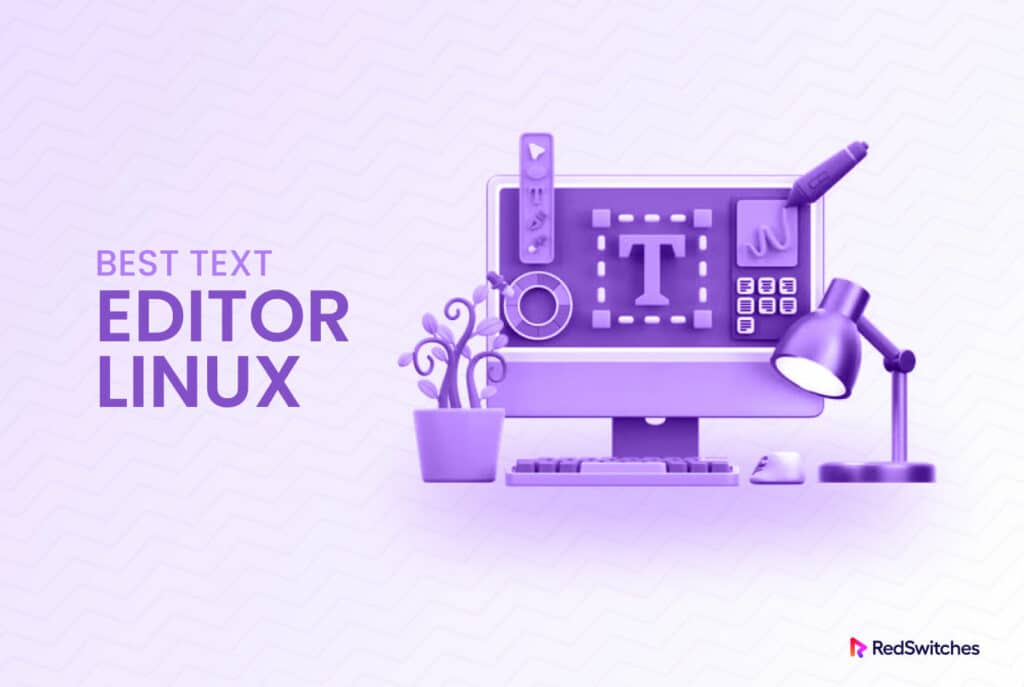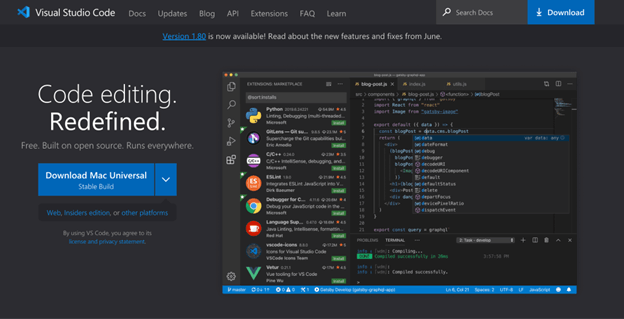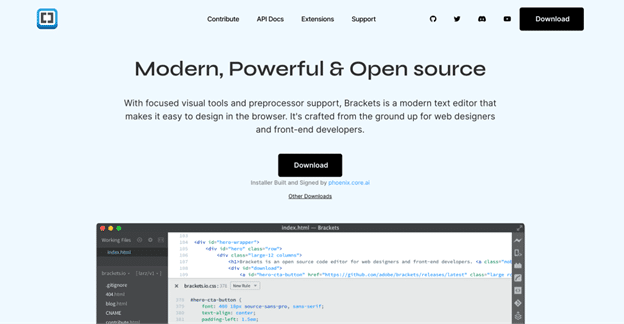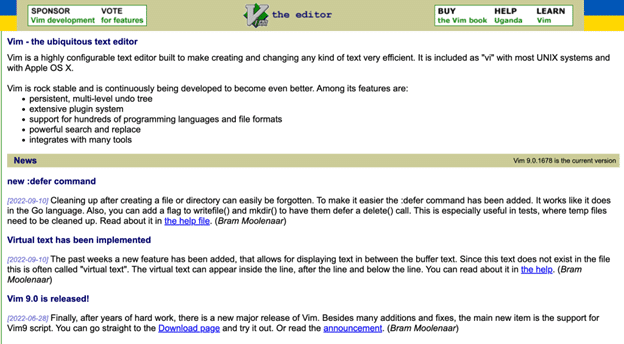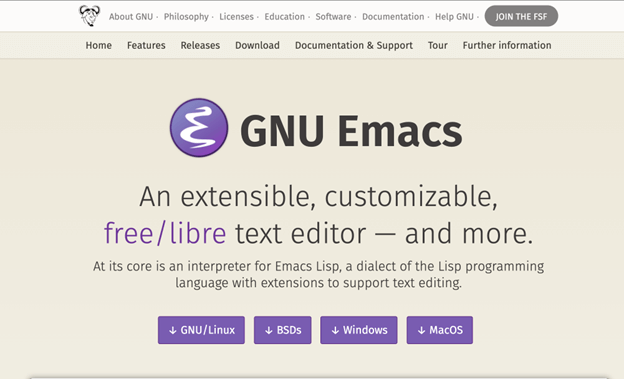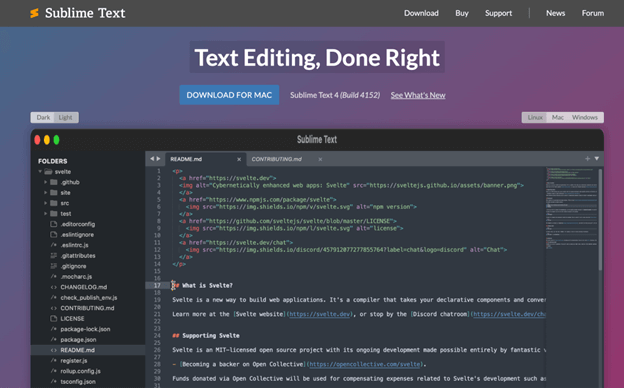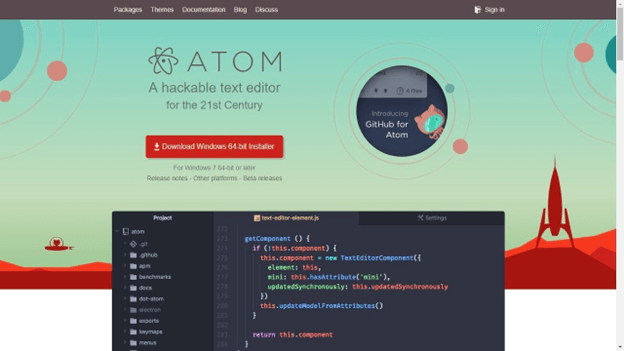A reliable text editor is a Linux user’s best friend. This applies whether you are an experienced developer navigating the numerous lines of code or a system administrator modifying configuration files. Do you want to speed up your Linux configuration and programming with a better text editor? If so, you’re not alone in thinking that way. As per a recent report by Stack Overflow, more and more professional developers are now using Linux as their primary operating system. However, the question of the “best text editor Linux” remains.
This post will dive into this important subject, discussing the most important considerations and highlighting the best Linux text editors. However, always keep in mind that there is no universally applicable solution. Your ideal text editor will vary depending on the specifics of your situation.
Now, let’s explore the many Linux text editors and help you settle on one that will aid you in your work.
Table of Content
- The Importance of Text Editors in the Linux Environment
- Evaluating the Best Text Editor for Linux: What to Look for
- Top Text Editors for Linux in 2024
- How Text Editors Impact Linux Server Management
- Explore Your Options with RedSwitches
- Conclusion
- FAQs
The Importance of Text Editors in the Linux Environment
Ah, the humble text editor. It might seem like a simple, unassuming tool, but don’t let that fool you. Text editors hold great power and versatility, especially within the Linux environment. These handy tools play a significant role in how you interact with your system, directly influencing your productivity and the quality of your work. In fact, for many novices, text editors are one critical difference between Linux and Unix.
Think about it this way. In the Linux world, where everything is file-based, a text editor resembles a Swiss Army knife. It’s a tool that enables you to create, modify, and manipulate files—ranging from scripts and source code to system configuration files and documentation. Are you a developer coding the next groundbreaking software? Or are you a system administrator managing vital system files? In either case, your text editor is the workbench for your tasks.
For programmers, a text editor is the canvas on which they paint code lines. It’s where they write, debug, and test their scripts or programs. A good text editor is equipped with features like syntax highlighting and auto-indentation, helping to reduce mistakes and improve readability. It can even provide autocomplete suggestions, saving programmers time and effort typing long code structures.
Text editors also play a vital role in system administration tasks. Many configuration settings on a Linux system are stored in text files; you’ll need a text editor to edit these settings. It allows sysadmins to tweak system configurations, manage user permissions, and even automate tasks via scripting.
Yet, not all text editors are created equal. In the diverse ecosystem of Linux, there’s a plethora of text editors, each boasting unique features, capabilities, and interfaces. Classic powerhouses like Vim and Emacs are popular choices. Modern, feature-rich options like Sublime Text and Visual Studio Code are also available; the abundance of choices can be overwhelming.
So, how do you find the “best text editor Linux” for your needs? What factors should you consider, and which features should you prioritize? This is what we’ll delve into in the following sections. So, stay tuned as we unravel the intricate tapestry of Linux text editors.
Evaluating the Best Text Editor for Linux: What to Look for
Selecting the best text editor Linux is no trivial task. As diverse as the Linux landscape is, so are its text editors, each bringing unique features, capabilities, and design aesthetics. So, what factors should guide your quest for the ideal text editor? Here’s what to keep an eye out for.
User Interface and Functionality
In the realm of text editors, the phrase “don’t judge a book by its cover” isn’t entirely accurate. A text editor’s user interface (UI) significantly influences the user experience. Therefore, finding one that looks visually appealing and caters to your comfort and workflow is crucial.
The functionality of a text editor is another significant factor to consider. The best text editor Linux is not just a tool to jot down and save text. It must support various features that can streamline your work and increase efficiency. Here are some core functionalities to look for:
- Syntax Highlighting: This feature colors different parts of your code (like variables, functions, keywords, etc.) in different shades, thereby enhancing readability and reducing the chances of syntax errors.
- Auto-Completion: Auto-completion is provided for coding fields to save time and effort. The coding process is sped up, and errors are minimized thanks to auto-completion, which recommends possible completions as you type.
- Search and Replace: This feature allows you to find specific words or phrases and replace them with others across the entire document. This saves you from manual searching and editing.
- Customizability: This is the ability to tailor the text editor to your preference. It covers everything from themes and layouts to keyboard shortcuts. These can enhance your comfort and speed up your work process.
Take note that the features listed here are just the fundamentals. Depending on your specific tasks, you might require more advanced features like integrated debugging tools, built-in terminals, or even version control systems. The aim is to find the perfect balance between user interface (UI) and functionality.
Your best text editor Linux should provide a user-friendly UI while delivering the powerful features required for your projects.
Extensibility
Once you have a firm grasp of the basics, the next level in your quest for the perfect text editor is extensibility. In essence, extensibility refers to the capability of the text editor to be enhanced or altered via the use of add-ons, plugins, or extensions. This characteristic is particularly important for users whose work often necessitates unique functionalities beyond the conventional features.
Imagine plugins and extensions as game power-ups – they allow your text editor to evolve and meet your changing needs. Many leading text editors have their own repositories of plugins. These offer functionalities ranging from advanced coding features and linting tools to integration with different tools. It may also cover fun features like theme and font changes.
For example, an XML plugin might assist in editing XML files by providing features like collapsible elements, syntax validation, and auto-tag closing. A Python plugin could offer an integrated Python console, enhanced syntax highlighting, and the ability to run and debug Python scripts.
Remember, extensibility isn’t just about quantity but also about quality. Ensure that the plugins are well-maintained and backed by a robust community. With a versatile and extensible text editor, the sky’s the limit.
Programming Language Support
In a diverse environment like Linux, users often juggle multiple programming languages. Hence, the best text editor Linux should be akin to a multitool, capable of accommodating many programming languages. This is where support for different programming languages becomes crucial.
At the most basic level, your text editor should be able to handle plain text files. It should also be able to handle configuration files written in languages like XML or JSON. However, if your role is that of a developer or programmer, you’ll require more. Compatibility with languages like Python, JavaScript, Ruby, and C++, among others, is vital.
A text editor with wide-ranging programming language support offers a few advantages. Firstly, it streamlines your workflow as you can work with different languages in one environment without swapping tools. Secondly, it provides functionalities like syntax highlighting, code folding, and auto-completion. The auto-completion feature should be tailored to the language you’re working with. This will enhance your productivity and improve your code quality.
So, when you’re assessing a text editor, make sure to verify its language compatibility. Do so for the languages you frequently work with or plan to learn in the future. A text editor that supports a wide array of programming languages ensures you’re well-equipped to face any coding task head-on.
Community Support
The last step in our journey to identify the best text editor Linux underscores the importance of community support. A text editor supported by an engaged community offers a multitude of benefits. Are you struggling with a complicated problem? You’ll likely encounter someone in the community who has faced it before and can guide you. Curious about new functionalities or features? You’ll find plenty of tutorials, blog posts, and forum discussions initiated by community members.
Moreover, a thriving community usually means a rich ecosystem of plugins and extensions, as previously mentioned. Many of these plugins are developed by community members and made available to others, thereby improving the overall functionality and versatility of the text editor.
Furthermore, community backing often plays a crucial role in steering the future direction of the text editor. Opinions, feedback, and even code contributions from community members can affect the progress and fine-tuning of the text editor. This ensures it stays relevant to the changing requirements of its users.
So, when evaluating your choices, don’t forget to assess the energy and size of the community surrounding each text editor. Peruse their forums, examine their social media engagement, or join a few discussions to gauge the community. A vibrant, active community can simplify your experience with your chosen text editor and make it more pleasurable and fulfilling.
We have examined the essential factors to consider in a text editor. Let’s explore some of the top contenders for the best text editor Linux in 2024.
Top Text Editors for Linux in 2024
Now, let’s redirect our focus to the core of this article: identifying the best Linux text editor options available in 2024. We’ve come to understand the importance of text editors in the Linux landscape and the critical aspects to consider when choosing. Now, we’ll closely examine the top contenders.
Visual Studio Code – The Versatile Choice
Let’s begin this list with a major player in the text editor domain: Visual Studio Code. Microsoft created Visual Studio Code. Often abbreviated to VS Code, it has rapidly become one of the most popular text editors, particularly among web developers.
One of its primary appeals is its extraordinary versatility. It supports many programming languages right out of the box, including, but not limited to, Python, JavaScript, TypeScript, C++, and C#. This makes it an ideal option for programmers working with various languages.
In addition, it boasts a sleek, user-friendly interface that can be customized to fit your working style. And let’s not forget its robust set of core features. Some of these include IntelliSense for smart completions, a built-in terminal, and a powerful debugger.
VS Code also shines in the extensibility department. Its extensive marketplace hosts thousands of plugins and extensions. These plugins and extensions can add all kinds of functionality to the editor. Everything from advanced version control support to new themes can be added in a few clicks.
Lastly, the active community surrounding VS Code ensures you’ll never be left in the dark when facing a challenge. The number of tutorials, guides, and discussion threads available online is nothing short of impressive.
Brackets – Web Development Editor
Next on our list is Brackets, a lightweight yet powerful text editor created by Adobe. As you might expect from a company with Adobe’s pedigree, Brackets is tailored for web development. This makes it an excellent tool for web designers and front-end developers.
Its standout feature is the Live Preview. This functionality lets you see changes in your code reflected in real time in your web browser. It’s a time-saver and a game-changer for those who need to see their design come to life as they code.
Brackets support HTML, CSS, and JavaScript out of the box, and it can be extended to support many other languages through its extension system. Speaking of extensions, Brackets boast a variety of them. Whether you need a linter, a new theme, or language support, chances are there’s an extension for that.
Community support is also strong for Brackets. You can find many tutorials and resources online to help you get the most out of this editor.
In sum, if web development is your main game, Brackets might be your best Linux text editor.
Now, let’s continue our exploration of top text editors for Linux with a few more feature-rich options.
IntelliJ IDEA – Android Development Editor
Continuing our journey, let’s move to IntelliJ IDEA, a sophisticated IDE (Integrated Development Environment) built primarily for Java. Don’t let that fool you; it supports many other programming languages, making it quite a versatile tool.
Developed by JetBrains, IntelliJ IDEA is a robust solution that Android developers appreciate. Its built-in tools are designed to make Android development smoother and more efficient, hence its significant popularity in this domain. Features like smart code completion, on-the-fly static code analysis, and powerful refactoring tools streamline the development process.
Moreover, IntelliJ IDEA integrates with many popular tools used in modern software development. Git, SVN, Gradle, Maven, and Docker are examples. It also boasts an impressive array of plugins, making extending its capabilities to fit your specific needs easy.
A vibrant community around IntelliJ IDEA ensures plenty of tutorials, guides, and resources are available to assist you on your development journey. If you’re looking for a potent tool to facilitate your Android development, IntelliJ IDEA could well be your best text editor Linux choice.
Vim – The Classic Powerhouse
Now, let’s turn our attention to a text editor that can genuinely be described as a classic in the world of Linux: Vim. Its roots go back to the early 90s, and it’s still going strong today, a testament to its power and flexibility.
Vim is a highly configurable text editor built to facilitate efficient text editing. It’s not merely a tool; it’s a whole philosophy of interacting with text. This might be a steep learning curve for some, but Vim can improve your productivity immensely once mastered.
Features that stand out in Vim include its modal editing. Each mode provides different functionalities and command languages. These allow you to combine commands in a virtually limitless number of ways. This might seem daunting to beginners, but the reward is a highly personalized text editing experience.
Another strength of Vim is its widespread presence. It’s available on almost every Unix-based system, including Linux, which makes it an excellent choice for server administrators or anyone who often works via SSH.
Community support for Vim is beyond exceptional, thanks to its long history and popularity. Online resources, tutorials, and plugins are abundant, ensuring you’re never stuck for long when using Vim.
Just remember, Vim requires a certain level of commitment to master. But once you do, you might find it to be the best Linux text editor for your needs. This is especially true if you value speed, efficiency, and customization above all else.
Emacs – The Extensible, Customizable Editor
Shifting gears, we now move towards a text editor that embodies the concept of extensibility and customization: Emacs. A veteran in the field of text editors, Emacs has a long history and a massive, dedicated user base.
At its core, Emacs is more than just a text editor. It’s an extensible, customizable, self-documenting real-time display editor. One could argue it’s a way of life, seeing how it can be customized remarkably. Sometimes it even functions as a full-fledged operating system.
Emacs has a built-in tutorial and extensive documentation, making learning and navigating the system easier. Key features include its advanced Lisp programming interface for customization, the ability to handle even large files efficiently, and a vast array of editing commands.
Despite its steep learning curve, the payoff can be substantial for those willing to commit. With Emacs, you have the freedom to build a working environment that fits exactly your needs.
The Emacs community is one of the most vibrant, with countless plugins and extensions available. Whether you’re a programmer, writer, or researcher, you will find Emacs a powerful tool, provided you’re ready to embrace its unique approach to text editing.
Sublime Text – The Sophisticated Editor
Let’s shift our focus to a more modern contender, Sublime Text. The sublime text combines simplicity and power in a sleek package, often touted as a sophisticated text editor for code, markup, and prose.
A standout feature of Sublime Text is its beautiful and user-friendly interface. Combined with its powerful performance and impressive speed, it provides a smooth and enjoyable user experience.
Key features of Sublime Text include:
- Goto Anything (fast navigation to files, symbols, or lines);
- multiple selections (making ten changes at the same time, not one change ten times); and,
- Command Palette (provides easy access to functionality).
Moreover, Sublime Text is highly customizable with JSON-based settings files. The package ecosystem and community support are impressive, allowing you to add just about any functionality you might need. Syntax highlighting for a vast array of languages, code snippets, and robust auto-completion make coding in Sublime Text a breeze.
For developers looking for an elegant yet powerful editor, Sublime Text might be the best text editor Linux option. It offers a balance of usability, aesthetics, and performance.
Atom – The Hackable Text Editor
Rounding off our list of top text editors for Linux, we introduce Atom, a tool developed by the team at GitHub. Atom is often described as a “hackable text editor for the 21st Century,” and for good reason.
Atom is an open-source text editor designed with flexibility and customization at its core. It’s built with web technologies, so it’s easily hackable to suit your needs. You can tweak the look and feel of your UI with CSS/Less and add major features with JavaScript/HTML.
Among Atom’s unique features is its integrated package manager. This tool allows you to search for and install new packages or create your own—all from within the editor. It also supports cross-platform editing, functioning on OS X, Windows, or Linux.
Other standout features include a built-in file system browser, find and replace function across all your projects, and smart autocompletion to assist with coding. Despite all these, Atom keeps its interface clean and uncluttered, maintaining an excellent user experience.
One area where Atom shines is its collaborative coding feature, Teletype. It lets developers share their workspace with team members, making it ideal for team projects.
In summary, Atom can be a great choice if you need a powerful, customizable text editor that’s friendly to use and backed by a strong community.
How Text Editors Impact Linux Server Management
Text editors play a pivotal role in managing and configuring Linux servers. They serve as the primary tool to create, modify and manage various configuration files that determine the behavior of a Linux system. Choosing the right text editor can simplify these tasks significantly and improve productivity.
For starters, having a good text editor can make writing and editing scripts for task automation easier, a common requirement in server management. If you’re working with configuration files, which is often the case with server management, features like syntax highlighting and line numbering can be invaluable.
Diagnosing problems is another useful function of text editors. Log files are a common tool for understanding what’s happening in a Linux system. A text editor that can open large files can make the difference between solving a problem quickly or struggling to open a log file.
Finally, programming language support is important for developers managing their servers. Whether you’re writing Python scripts to automate server tasks, a text editor with robust support for your chosen language can make your life easier. Similarly, a reliable text editor can significantly simplify your tasks if you’re programming in C for system-level work.
The choice of text editor, thus, can have a direct impact on the effectiveness of Linux server management. Do you find the bare-bones simplicity of Vim appealing? Perhaps you lean towards the extensible power of Emacs or the modern, user-friendly environment of Atom or Sublime Text. Regardless, the best text editor Linux is ultimately the one that fits your server management style and requirements.
As you learn more about what is a dedicated server, major dedicated server types, and the right dedicated server specs for your projects, you’ll find yourself using your favorite text editor for editing the text-based config files of the machine servers.
Read more about the cloud server vs dedicated server and shared server vs dedicated server debates to make informed business decisions.
Explore Your Options with RedSwitches
Finding the best text editor Linux is just one part of managing a Linux system. RedSwitches has extensive server options if you’re looking for robust server solutions. Reach out for personalized advice based on your business needs.
Discover how the right server, coupled with the right text editor, can optimize your Linux experience. Explore RedSwitches’ server options is one of the best dedicated server hosting providers for Linux projects. We offer the best dedicated server pricing and deliver instant dedicated servers, usually on the same day the order gets approved. Whether you need a dedicated server, a traffic-friendly 10Gbps dedicated server, or a powerful bare-metal server, we are your trusted hosting partner.
Conclusion
The journey to find the “best text editor for Linux” can be as varied and diverse as Linux users themselves. There’s much to consider, from understanding the importance of text editors in the Linux environment to the factors that shape their selection. Interface, functionality, extensibility, programming language support, and community backing can all influence the choice of a text editor.
Whether you’re drawn to the versatile Visual Studio Code, the web-friendly Brackets, the robust IntelliJ Idea for Android development, the powerful Vim, the customizable Emacs, the sophisticated Sublime Text, or the hackable Atom, remember that the choice ultimately depends on your specific needs and preferences.
If you’re managing servers like those provided by RedSwitches, a provider specializing in Bare-Metal Server & Dedicated Servers, the right text editor can further simplify and enhance your server management tasks.
Searching for the best text editor Linux isn’t just about the most popular or powerful option. You need to choose what works best for you. Choose what fits your work style and ultimately boosts your productivity.
FAQs
Q-1) Which text editor should I use Linux?
The choice of a text editor depends largely on your needs and preferences. Consider factors such as interface, functionality, extensibility, language support, and community backing while choosing.
Q-2) What is the best text editor for Linux terminal?
Vim and Emacs are often favored for terminal usage due to their powerful features and keyboard-centric operation. However, the best editor will depend on your comfort level and needs.
Q-3) What is the fastest text editor for Linux?
Lightweight best text editor Linux like Vim and Nano are known for speed. However, speed can vary depending on your system resources and the size of the files you’re working on.
Q-4) What can I use instead of gedit?
There are many alternatives to gedit, like Vim, Emacs, Sublime Text, Atom, and Visual Studio Code, to name a few. The choice depends on your specific needs and preferences.
Q-5) Is Vim a Linux text editor?
Vim is a highly configurable text editor built to enable efficient text editing. It’s often used in Linux terminal environments, but GUI versions are also available.
